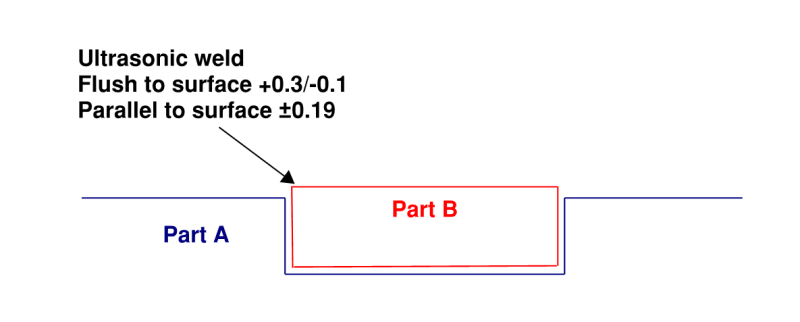Hi there,
I have an interesting drawing callout that states the following
- Flush to surface +0.3/-0.1
- Parallel to surface within ± 0.19
There is no datum specified.
This is an assembly of two injection molded parts, assembled via ultrasonic welding. For the sake of this thread, we can call the main part Part A and the component that is welded into place, Part B. I cannot attach a screenshot of the drawing, but here is a quick sketch of the dilemma, for reference.

I understand that parallelism in the conventional way is not the same as one surface being flush to another surface within a given tolerance, unless that surface is also the datum.
I talked to someone who has more history with this part and he gave me the following summarized interpretation:
- Since no datum is clearly defined, the surface of Part A is the implied datum. Therefore, the first part of the note gives a tolerance band around the surface of Part A, that the surface of Part B can be located in. So surface of Part B can be 0.3mm above or 0.1mm below the surface if Part A. The parallelism is applied in the same manner, so surface of Part B can be located within a tolerance band of ±0.19mm around surface of Part A. Since these tolerance bands overlap, they could technically be combined into a single tolerance band of +0.3/-0.19.
I'm looking for feedback on this interpretation. Are these two call outs truly synonyms with only a difference in tolerance?
Thank you in advance!
I have an interesting drawing callout that states the following
- Flush to surface +0.3/-0.1
- Parallel to surface within ± 0.19
There is no datum specified.
This is an assembly of two injection molded parts, assembled via ultrasonic welding. For the sake of this thread, we can call the main part Part A and the component that is welded into place, Part B. I cannot attach a screenshot of the drawing, but here is a quick sketch of the dilemma, for reference.

I understand that parallelism in the conventional way is not the same as one surface being flush to another surface within a given tolerance, unless that surface is also the datum.
I talked to someone who has more history with this part and he gave me the following summarized interpretation:
- Since no datum is clearly defined, the surface of Part A is the implied datum. Therefore, the first part of the note gives a tolerance band around the surface of Part A, that the surface of Part B can be located in. So surface of Part B can be 0.3mm above or 0.1mm below the surface if Part A. The parallelism is applied in the same manner, so surface of Part B can be located within a tolerance band of ±0.19mm around surface of Part A. Since these tolerance bands overlap, they could technically be combined into a single tolerance band of +0.3/-0.19.
I'm looking for feedback on this interpretation. Are these two call outs truly synonyms with only a difference in tolerance?
Thank you in advance!
